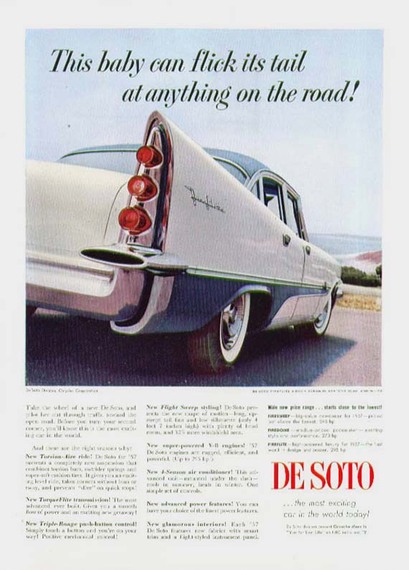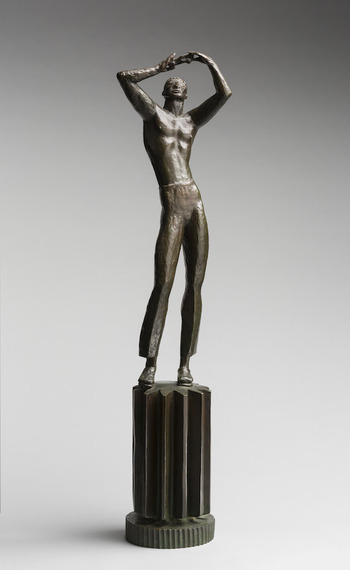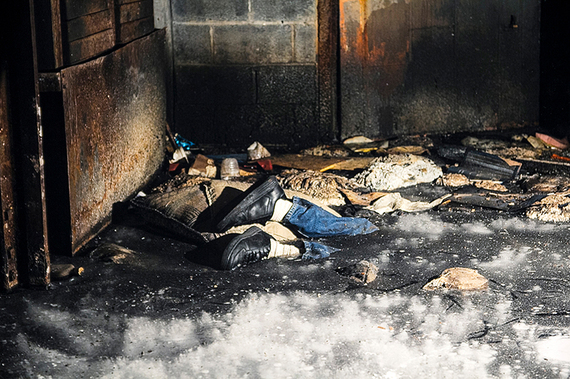Pericles was born in 495 B.C. Aristotle died in 322. People who were born and died between those years include Praxiteles, Euripides, Herodotus, Thucydides, Socrates, and Plato. The Parthenon and the Long Walls were built. The Persian and Peloponnesian Wars were pursued and completed. Many of the core concepts and even specific works and images which, for us, constitute civilization, came to be in this shimmering 173-year interval.
Now consider an Athenian born the day Aristotle died. He is the inheritor of breathtaking riches; his city is the crown of culture. But as he grows into his thirties, forties, fifties, age will confide to him that things really are worse than they used to be. Titans bestrode the Earth only one generation before his own. He is not one. None live now. He will not live to see their return. They will not be coming back to Athens.

Ford Motor Company, 1957 DeSoto Advertisement, "This Baby Can Flick its Tail at Anything on the Road!", 1957, paper, from the Collections of The Henry Ford Museum, Dearborn, MI
Todd Levin, curator of the sprawling two-gallery group show Another Look at Detroit, at Marlborough Chelsea and Marianne Boesky Gallery until August 8, finds himself in something like the position of our last Athenian. A Detroit native and passionate advocate for Detroit, he has compiled a century and a half of art and design into this portrait of his city. His press release cites the city's motto, Speramus Meliora; Resurget Cineribus ("We hope for better things; It shall rise from the ashes.") But his show seems overwhelmingly sad to me.

Carl Milles, Man with Automobile, 1933, bronze, courtesy of Cranbrook Academy of Art, Bloomfield Hills, MI
It is, on the one hand, like a yearbook from a high school you did not attend. It freezes the motion of a community into a series of glimpses of moments, of scenes and places in progress, of people living lives that you never touched. You can see that they were full of life, but they are vanished now. You can understand that those who knew them will shed tears as these memories parade again before their eyes. But it is an open question whether you, a stranger, ought to care.

Bill Rauhauser, Conversation, c. 1955-1960, pigment print on archival paper, courtesy Hill Gallery, Brimingham, MI © Bill Rauhauser
On the other hand, this show is a catalogue of the history of American civilization itself. As an American, you must make it your yearbook; there is no other. I am personally indifferent to much of the art on display, as art. And yet in its capacity as chronicle of a nation in transit from youthful confidence and vigor, to indulgence and mania, and finally to decrepitude and dissolution, I cannot turn away from it. It is a haunting draft of the story of the country at large. As it goes, so we, perhaps, will go. America did not turn out as the founders imagined it. Some of it was better, some worse. This show writes a tender elegy to the lives and deaths of the Americans.

Mike Kelley, Center and Peripheries #2, 1990, acrylic on panels and wood armatures, courtesy: private collection
And on the third hand, there is Levin's implicit claim: that even if Detroit should be swept away, it will have contributed, in its art, to the ongoing story of humanity. In such a sense, it is not a yearbook nor the record of a nation, but an idea, and ideas are not born nor do they die. Levin makes his claim from the center of his passion for Detroit; I make my evaluation from my own imperfect perspective. Does he have a point? Time will tell. For what it's worth, I think he has one, in places. Consider two pieces from the show. First is the 1863 Morning, by Robert Duncanson.
Duncanson's painting partakes of that wild hope the vast and unspoiled American landscape inspired in its settlers, who carried with them the cramped burdens of Europe, and sought to set them down on the shores of the new world. A little research reveals that Duncanson, who is linked to the Hudson River School of painting, was black, descended from Virginia slaves. In my eyes, his work demonstrates that the American hope is a hope beyond race. It belongs to him as much as it does to his white brethren. His painting of morning, therefore, is a morning of civilization.
Now we jump to 2009.
You don't really need the title. You can tell that poor dead man is frozen solid with the water in which he is only partially submerged. He must have died when the weather was warmer, and nobody came for him then or anytime since. He is in a shitty little place, choked with rubbish, himself rubbish, disposed of without ceremony, snatched back from the void of forgetfulness only by the rude lens of the photographer. This is a powerful image of barbarity, of society in a state of decline so far advanced that it has reached the stage of disappearance. In his press release, Levin vows to avoid "the misguided aesthetics of destruction porn." And indeed he has. You would scarcely know from the show what became of Detroit, without this one harrowing picture, which is not so much porn as brutal art. It is the telling moment, the fierce truth of the thing.
Duncanson's Morning and Ortiz's Johnnie Redding Frozen in Elevator Shaft are, for me, the essentials of Another Look at Detroit. When the rest has faded, this disastrous combination will remain. They state without explanation. We see what they say, and we know that it is true. As for the rest of the show - all the industrial design, the cars and advertisements, bustling citizens and color and music and concepts and manifestos - all this may have an explanation in it, somewhere. In this sense it is material for anthropologists and historians, who will no doubt go down arguing for generations more over how and when morning turned to night.
---
Another Look at Detroit
curated by Todd Levin
Marianne Boesky Gallery, 509 W. 24th St., NY, NY, 10001
Marlborough Chelsea Gallery, 545 W. 25th St., NY, NY, 10001
through 8 August


